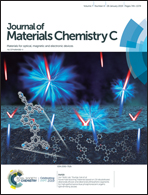Novel hole blocking materials based on 2,6-disubstituted dibenzo[b,d]furan and dibenzo[b,d]thiophene segments for high-performance blue phosphorescent organic light-emitting diodes†
Abstract
Novel hole blocking materials (HBMs) based on 2,6-disubstituted dibenzo[b,d]furan and dibenzo[b,d]thiophene segments, 3,3′,3′′,3′′′-(dibenzo[b,d]furan-2,6-diylbis(benzene-5,3,1-triyl))tetrapyridine (26DBFPTPy) and 3,3′,3′′,3′′′-(dibenzo[b,d]thiophene-2,6-diylbis(benzene-5,3,1-triyl))tetrapyridine (26DBTPTPy), are successfully designed and synthesized for high-performance blue phosphorescent organic light-emitting diodes (PhOLEDs) for the first time. Computational simulation is used to investigate the optimal structure, orbital distribution, and physicochemical properties of both molecules. Thermal, optical, and electrochemical analysis shows that 26DBFPTPy and 26DBTPTPy possess high thermal stability, deep HOMO energy levels (−7.08 and −6.91 eV), and a high triplet energy (ET) (2.75 and 2.70 eV). Blue PhOLEDs with 26DBFPTPy or 26DBTPTPy as a hole blocking layer (HBL) exhibit a low turn-on voltage (3.0 V) and operating voltage (4.5 V) at 1000 cd m−2. In addition, the blue PhOLEDs with 26DBFPTPy or 26DBTPTPy show superior external quantum efficiencies (24.1 and 23.6%) and power efficiencies (43.9 and 42.7 lm W−1). They also show a very small efficiency roll-off of about 8.5% from 100 to 1000 cd m−2. Furthermore, they exhibit improved lifetimes compared to the similarly designed HBL with a pyridine electron transport unit and a phenyl core structure.
![Graphical abstract: Novel hole blocking materials based on 2,6-disubstituted dibenzo[b,d]furan and dibenzo[b,d]thiophene segments for high-performance blue phosphorescent organic light-emitting diodes](/en/Image/Get?imageInfo.ImageType=GA&imageInfo.ImageIdentifier.ManuscriptID=C8TC04900A&imageInfo.ImageIdentifier.Year=2019)


 Please wait while we load your content...
Please wait while we load your content...